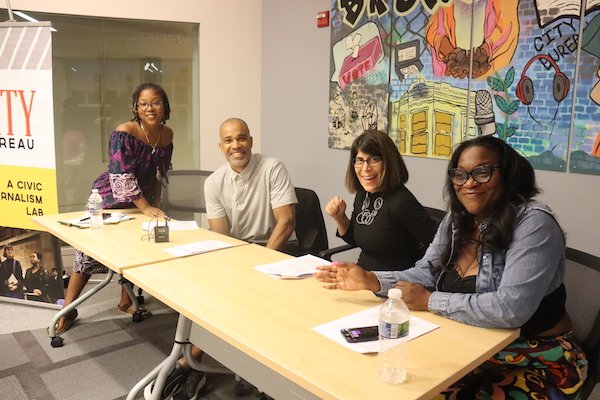Ahead of a new collaborative investigation from City Bureau and the Invisible Institute, this latest Public Newsroom examined why Black youth run away and experience homelessness at such high rates and what it may take to address these challenges.
By Maia McDonald
Public Newsroom 151 moderator Trina Reynolds-Tyler and panelists Forrest Moore, Susan Frankel and Nikki McKinney focused on the root causes of youth homelessness Aug. 30, 2023, leading up to a forthcoming report from City Bureau and the Invisible Institute about police handling of missing person cases. (Photo: Maia McDonald/City Bureau)
A version of this article was first published in the Documenters Newswire newsletter on September 1, 2023.
Building on a soon-to-be-published City Bureau and Invisible Institute collaboration from reporters Sarah Conway and Trina Reynolds-Tyler looking into how Chicago police handle missing persons cases and how families of the missing are affected, City Bureau hosted its latest Public Newsroom on Wednesday, Aug. 30.
So far, their reporting found that Black people make up nearly two-thirds of all missing person cases reported to the Chicago Police Department over the last 20 years, and nearly 60% of those cases involve Black children under the age of 21.
The panel, moderated by Reynolds-Tyler, featured experts discussing the prevalence of missing Black teens and how a variety of factors can lead youth to homelessness, sex work, trafficking and other challenges:
Nikki McKinney, a Chicago activist, mother and student, and lead organizer and co-creator of the Street Youth Rise Up Campaign, a direct action and research group centered on youth homelessness in Chicago.
Susan Frankel, chief executive officer of the National Runaway Safeline (NRS), a 24-hour hotline for youth who’ve run away or who are considering doing so.
Forrest Moore, a policy fellow at Chapin Hall, who helps youth-serving agencies by providing guidance on research and evidence use.
Here are some key takeaways:
Youth who choose to run away or are considering it often do so after failures from adults in their lives to help them address and navigate complex issues.
From teachers to doctors to managers at work and other community members they encounter, Moore said these adults may fail to notice the ways a youth is struggling. Frankel agreed, saying that when she talks to young people who call in to the National Runaway Safeline, very few received help from adults, often still attending school while living on the street, engaging in sex work or navigating abusive family dynamics.
“One young woman was with her dad, at 14 years old, almost daily at the hospital. Someone at the hospital should have asked, ‘Why are you not at school; what do you need; how can we help?’” Frankel said.
To successfully address youth homelessness, community members and local stakeholders will need to meet young people where they are.
To help youth in crisis, Frankel and others at the National Runaway Safeline look at their options and what they need to feel safe and have agency in their lives, she said.
“What we are seeing is that it’s very, very brave and courageous for anybody to reach out for help,” Frankel said. “So we are really working with them to look at what their options are, and to help them think through what their safest choice might be … instead of us deciding what’s best for them.”
Additionally, Nikki McKinney said they believe active players in the child welfare system like the Department of Children and Family Services need to rebuild systems from the ground up to help youth — including re-evaluating how they employ local police officers and security guards, which some youth may not trust.
Systems of oppression are a big contributing factor to youth homelessness.
“What happens in society [is] we immediately go to blaming the family,” said Moore, adding, “There’s a tremendous amount of family breakdown for a young person to be left alone.”
However, Moore believes it’s important to recognize how youth homelessness is a symptom of oppression, and how larger systems fail to serve youth and their families. This recognition helps identify where problems occur and how to support familial structures to remain intact, he said.
“Due to oppression, people are stripped of a lot of things and left to sort of figure it out, to build and create agency,” he said.
A lack of communication between systems like the health care industry, schools and the police can contribute to youth homelessness, Moore said. Because they’re not designed to work holistically and collaboratively, communication issues discourage young people from sharing when they’re experiencing challenges.
Additionally, because data-sharing and interaction between these groups is often limited, helping youth at risk of homelessness is limited as well.
About the Author
Maia McDonald is a Chicago-based freelance journalist and former City Bureau Civic Reporting Fellow. She has reported on a multitude of topics for local newsrooms, including Block Club Chicago, Borderless Magazine, The TRiiBE and others. You can follow her at @maiamcdonld or check out her Muckrack page for a look at her recent work.
Want to check out the full Public Newsroom conversation? Watch here on our YouTube:
Support City Bureau’s reporting on local government and transparency by becoming a recurring donor today.

